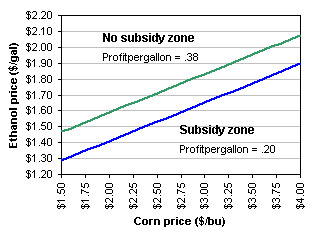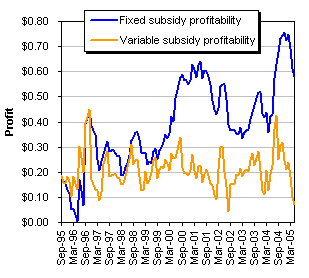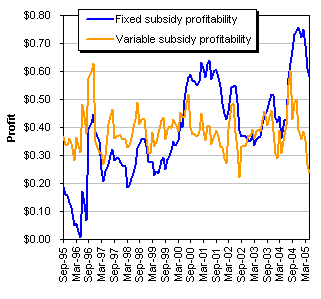|
When the government subsidizes a commodity, it normally intends to promote production and/or consumption of that commodity for either political, environmental, or economic reasons. Today one major subsidy is the ethanol program, currently with a $0.51 per gallon subsidy, which will in the near future amount to a bill of over $3 billion annually on 6 billion gallons of production. This paper investigates the effectiveness of the subsidy and asks whether a cheaper alternative could be developed.
Like any government expenditure, the value of a subsidy must be judged on how well it achieves its intended objective - in this case, stimulating the production/consumption of ethanol, and thereby increasing corn demand. How well the objective is achieved can be measured by the stimulus to production versus the cost to the government. Stimulus to production should be tied to the effect of the subsidy on expected profitability and the change in risk for investors.
A fixed subsidy could change the expected profitability simply by adding to the expected profit without the subsidy. However, if profit without the subsidy were already high, as at present, the subsidy might have a small impact on investment decisions and ethanol production. On the other hand, a subsidy that was larger with lower ethanol prices or higher input costs could reduce risk substantially and stimulate greater production through that risk reduction.
Today with ethanol prices near $3 per gallon, the industry is very profitable without a subsidy, and the added profit from the subsidy likely induces little additional investment. However, if wholesale gasoline and ethanol prices were to fall below $1 per gallon again, the subsidy would provide substantial incentive for additional investment. So, while we cannot predict the change in investment for any given subsidy approach, we can estimate the change in profitability and risk and compare that with the government cost for each approach.
The current ethanol subsidy is a flat 51 cents per gallon of ethanol paid to the agent that blends ethanol with gasoline. In the past it took the form of a partial or total gasoline excise tax exemption, but today it is a tax credit for the ethanol blender (Renewable Fuels Association, 2006). The subsidy is paid regardless of ethanol price or production cost.
It is possible to develop a subsidy that falls as the price of ethanol increases and increases as the price of corn falls. Here, we develop such a subsidy and compare it with the current subsidy, examining the difference in government cost, and ethanol producer risk and profitability with monthly data from the past ten years. As shown below, we find that government cost and ethanol producer risk is always lower with the variable subsidy, and expected profitability can be the same or lower compared to the fixed subsidy, depending on one of the subsidy parameters. The rest of this paper provides more details on the design of the variable subsidy program and the empirical comparison.
Subsidy Design
In order to set up a variable subsidy, we need to examine ethanol profitability under a wide range of corn and ethanol prices. Tiffany and Eidman's (2003) spreadsheet was used to estimate profitability. Ethanol production uses corn and generates byproducts and ethanol. That spreadsheet model provides a profitability estimate given an ethanol price, a corn price, and a price for byproducts. One item needed was a price for the main ethanol byproduct, distillers dried grain with solubles (DDGS). DDGS can be used in feeding to replace corn and soybean meal, and thus its price is highly correlated with corn and soybean meal prices. Using historic data, we estimated a relationship between those prices that explains 73% of the DDGS price variability:
DDGS Price = -9.205 + 1.037 (CornPrice) + .135 (SoyMealPrice)
where all prices are dollars per ton.
We then used the model to simulate profitability given corn and ethanol prices holding the soybean meal price at $223.42 per ton. In turn, the profitability data were used to estimate the dependence of ethanol profitability on corn and ethanol prices. The results for profits per gallon produced are
Profits = -.723 + 1.00* EthanolPrice -.243* CornPrice
where profits and ethanol price are in units of $/gallon, and CornPrice is $/bushel. The regression explains almost all the variance in the data (99.9%), which is a reflection of the linear formulas involving these prices in the spreadsheet.
Next, we develop a variable subsidy scheme. To do that, we introduce a profit level per gallon in excess of the standard 12% rate of return assumed in the Tiffany/Eidman model simulations (Profitpergallon), and calculate the subsidy needed to achieve that profit. The equation for the subsidy then becomes:
Subsidy = -.723 - Profitpergallon +1.00EthanolPrice - .243CornPrice
Converting the subsidy to a positive value and rearranging terms, the subsidy equation becomes:
Subsidy = Profitpergallon - (EthanolPrice - .723 - .243 * CornPrice)
Thus, the subsidy is the difference between the above-normal profit level assumed (Profitspergallon) and the returns from the market (ethanol price less production costs). The variable subsidy with this formulation is constrained to be greater than or equal to zero.
Magnitude of the Subsidy in the Formula
Table 1 provides the expected profit from the Tiffany/Eidman model, plus the profit under the current 51 cents per gallon fixed subsidy and the variable subsidy (assuming the ethanol producer receives the entire subsidy).1 If corn were $2.50/bu., ethanol $1.50/gal., and the specified above normal profit (Profitpergallon) 20 cents per gallon, then the variable subsidy would be equal to 3 cents per gallon. In other words, a subsidy of 3 cents per gallon is required to maintain profitability at 20 cents above standard economic return (assumed to be 12% on equity). The subsidy could be much higher. For example, if corn were $4.00 and ethanol $1.25 like in 1996, and Profitpergallon = 0.20, the subsidy would be 65 cents per gallon - higher than the current subsidy. Clearly, the variable subsidy reduces private sector risk by stabilizing returns.
When Would We Have Zero Subsidies?
Figure 1 illustrates the combination of corn and ethanol prices that result in zero subsidy with the above standard return (Profitpergallon) set equal to 20 cents per gallon and 38 cents per gallon. In Figure 1, any combination of corn and ethanol prices below the line will result in a subsidy, with the amount depending on corn and ethanol prices. Any combination of corn and ethanol prices on or above the line will result in no subsidy. In the no subsidy zone, a subsidy is not needed to maintain ethanol profitability at the given 20 or 38 cents per gallon level, and any subsidy provided by government is a substantial, perhaps excess, payment to producers.
Historical Comparison with the Fixed Subsidy
We also calculated private profitability and government cost with the variable and fixed subsidies using data on corn and ethanol prices over the past ten years. We did the analysis using a subsidy that changed quarterly and was based on either ethanol or gasoline prices. Table 2 summarizes the results of this analysis for different levels of above-standard profit (Profitpergallon).
The results show
- The variable subsidy reduces government cost uniformly across these data.
- The lower the value of Profitpergallon, the higher the cost savings for the government and the lower the expected profitability.
- The variability in private sector profitability (a measure of risk) as measured by the coefficient of variation (CV) of profit is always lower with the variable subsidy as compared with the fixed subsidy, as would be expected.
- Expected profitability is reduced or held constant depending on the value of Profitpergallon.
In other words, we can hold expected profit and government cost about the same and significantly reduce producer risk, or we can lower expected profit, government cost, and producer risk all at the same time, but to differing degrees. Figure 2 illustrates the results of this analysis with Profitpergallon set at 20 cents and Figure 3 with Profitpergallon equal 38 cents.
Concluding Comments
In 2007, ethanol production may be about 6 billion gallons. With the current fixed subsidy, the cost to the government of the ethanol subsidy will be at least $3 billion (6 billion gallons times the 51 cent per gallon subsidy). With the variable subsidy, and under current market prices for gasoline, ethanol, and corn, the variable subsidy cost would be zero, saving the government over $3 billion. At the same time, the private sector would have in place a mechanism to guarantee against any future adverse changes in corn or ethanol prices.
The variable subsidy clearly offers advantages over the current fixed subsidy. In our model, the additional profitability parameter, Profitpergallon, can be viewed as a political choice variable. The higher one sets Profitpergallon, the higher the industry profitability, the higher government cost, and the lower private sector risk. Under no circumstance was the variable subsidy more costly than the fixed subsidy over this historic period. To the extent there is a trade-off between expected profitability and risk reduction (that is, producers would give up some profit to lower risk), the government would be able to set Profitpergallon low enough to reduce expected government costs and substantially reduce private sector risk at the same time - a clear win-win. In a few years, the expected production of ethanol will be 8 billion gallons or more. The annual cost to the government with the fixed subsidy would be $4.08 billion. If oil prices remain high, the variable subsidy would cost nothing, but would provide a safety net for ethanol producers.
As described above, this variable subsidy would apply only to corn-based ethanol. This mechanism would need to be applied to a limited volume of corn ethanol or gradually converted to a subsidy that varies with gasoline prices alone. A different mechanism would need to be developed for cellulose-based ethanol and bio-diesel, probably based on gasoline and diesel prices. The point is that it would be relatively easy to extend the corn-based variable subsidy to the other products.
Notes
1 It is unlikely that the ethanol producer receives the entire subsidy, since there are other economic actors in the system. However, there is no basis for calculating the share the ethanol producer receives. In addition, there is no reason to believe that the share, whatever it is, would differ between the two systems.
For More Information
Quear, J., & Tyner, W.E. (2006). Development of a Variable Ethanol Subsidy. Purdue University working paper available from the authors.
Renewable Fuels Association (RFA) (2006). From niche to nation: Ethanol industry outlook 2006. Available online: http://www.ethanolrfa.org/.
Tiffany D.G., & Eidman, V.R, (2003). Factors associated with the success of fuel ethanol production (Staff Paper P03-7). Department of Applied Economics, University of Minnesota. Available online: http://www.agmrc.org/NR/rdonlyres/CB852EC6-0DB7-4405-944F- 59888DD6D344/0/ethanolsuccessfactors.pdf.
|
|
Table 1
Expected ethanol profit under the two subsidy systems over a range of corn and ethanol prices.
| 2.00 |
1.25 |
0.04 |
0.55 |
0.20 |
| 2.00 |
1.50 |
0.29 |
0.80 |
0.29 |
| 2.00 |
2.00 |
0.79 |
1.30 |
0.79 |
| 2.00 |
2.50 |
1.29 |
1.80 |
1.29 |
| 2.00 |
3.00 |
1.79 |
2.30 |
1.79 |
| 2.50 |
1.25 |
-0.08 |
0.43 |
0.20 |
| 2.50 |
1.50 |
0.17 |
0.68 |
0.20 |
| 2.50 |
2.00 |
0.67 |
1.18 |
0.67 |
| 2.50 |
2.50 |
1.17 |
1.68 |
1.17 |
| 2.50 |
3.00 |
1.67 |
2.18 |
1.67 |
| 3.00 |
1.25 |
-0.20 |
0.31 |
0.20 |
| 3.00 |
1.50 |
0.05 |
0.56 |
0.20 |
| 3.00 |
2.00 |
0.55 |
1.06 |
0.55 |
| 3.00 |
2.50 |
1.05 |
1.56 |
1.05 |
| 3.00 |
3.00 |
1.55 |
2.06 |
1.55 |
| 4.00 |
1.25 |
-0.45 |
0.07 |
0.20 |
| 4.00 |
1.50 |
-0.20 |
0.32 |
0.20 |
| 4.00 |
2.00 |
0.31 |
0.82 |
0.31 |
| 4.00 |
2.50 |
0.81 |
1.32 |
0.81 |
| 4.00 |
3.00 |
1.31 |
1.82 |
1.31 |
|
|
Table 2
Ethanol profitability, risk reduction, and government cost.
| Average producer profit/gallon |
$0.39 |
$0.21 |
$0.31 |
$0.39 |
| Reduction in producer profit |
|
-46% |
-21% |
0% |
| Variability of producer profit (CV) |
0.43 |
0.34 |
0.23 |
0.18 |
| Change in profit variability (CV) |
|
-21% |
-47% |
-58% |
| Government cost per gallon |
$0.51 |
$0.32 |
$0.42 |
$0.50 |
| Change in government cost |
|
-37% |
-18% |
-2% |
|
|



